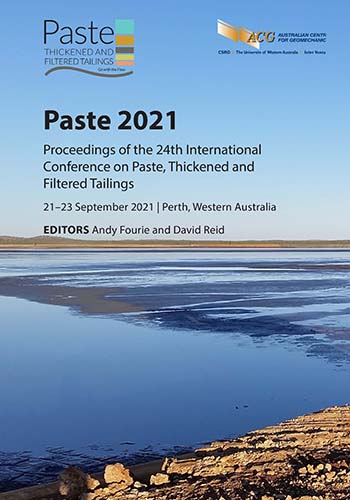Some considerations when preparing thickened tailings for shear strength testing in the laboratory from a slurry

|
Authors: Reid, D; Fanni, R; Fourie, AB |
DOI https://doi.org/10.36487/ACG_repo/2115_17
Cite As:
Reid, D, Fanni, R & Fourie, AB 2021, 'Some considerations when preparing thickened tailings for shear strength testing in the laboratory from a slurry', in AB Fourie & D Reid (eds), Paste 2021: Proceedings of the 24th International Conference on Paste, Thickened and Filtered Tailings, Australian Centre for Geomechanics, Perth, pp. 203-216, https://doi.org/10.36487/ACG_repo/2115_17
Abstract:
Preparation of tailings in the laboratory to simulate the likely range of densities and resulting behaviour that will occur under load in situ is challenging. A number of issues of relevance include whether effects such as subaqueous deposition can be reproduced at all in the laboratory, and the potential importance of in situ layering of segregating tailings. These issues may have (thus far, largely unquantified) effects on mechanical behaviour in ways that are difficult to predict with element tests that are usually intentionally prepared homogeneously. Thickened tailings testing is conceptually easier, as issues such as segregation and the potential for subaqueous deposition are often not relevant. Despite this relative simplicity, a number of important considerations remain. While it is trivial to pour a thickened slurry into various forms of moulds or vessels to prepare for element testing, questions remain over whether the density that is reproduced will be relevant to in situ conditions. In particular, preparation of triaxial samples from thick slurries is particularly challenging as a number of steps are required to enable such samples to be ‘free-standing’, with each one of these steps potentially leading to slight disturbance and thus densification of the sample. Where such densification occurs, it would result in the element test results being non-conservative. This could have important implications with respect to expectations of the contractive (and potentially liquefiable) or dilative response of the tailings in situ. To investigate these issues, a series of slurry-deposited triaxial tests was carried out using a non-segregating slurry. As test methods were refined during the program, the amount of disturbance applied to the specimen was reduced. However, comparison of the triaxial tests to slurry consolidometer tests indicated that, regardless of efforts made, the triaxial tests achieved denser states at a given amount of consolidation stress. This was found to be the case using any conceivable range of assumed geostatic stress ratio to interpret the slurry consolidometer results. This outcome is speculated to be a result of the quiescent conditions used in the preparation of a slurry consolidometer specimen, which only requires pouring and then application of vertical load, first using weights, then a load frame. The implications of the increased density seen in triaxial tests compared to the likely more realistic value seen from the slurry consolidometer are discussed. Alternative preparation methods to target this looser density range are briefly discussed.
Keywords: laboratory testing, liquefaction, thickened tailings
References:
Ayala, J, Fourie, A & Reid, D 2020, ‘Cone penetration testing on silty tailings using a new small calibration chamber’, Géotechnique Letters, vol. 10, no. 4, pp. 492–497.
Baziar, MH & Dobry, R 1995, ‘Residual strength and large deformation potential of loose silty sands’, Journal of Geotechnical Engineering, vol. 121, no. 12, pp. 896–906.
Carraro, JAH & Prezzi, M 2008, ‘A new slurry-based method of preparing specimens of sand containing fines’, Geotechnical Testing Journal, vol. 31, no. 1, pp. 1–11.
Chang, N, Heymann, G & Clayton, C 2011, ‘The effect of fabric on the behaviour of gold tailings’, Géotechnique, vol. 61, pp. 187–197.
Donahue, J, Bray, J & Riemer, M 2008, Liquefaction Susceptibility, Resistance, and Response of Silty and Clayey Soils, University of California, Berkeley.
Høeg, K, Dyvik, R & Sandbækken, G 2000, ‘Strength of undisturbed versus reconstituted silt and silty sand specimens’, Journal of Geotechnical and Geoenvironmental Engineering, vol. 126, pp. 606–617.
Hyde, AFL, Higuchi, T & Yasuhara, K 2006, ‘Liquefaction, cyclic mobility, and failure of silt’, Journal of Geotechnical and Geoenvironmental Engineering, vol. 132, no. 6, pp. 716–735.
Ishihara, K, Tatsuoka, F & Yasuda, S 1975, ‘Undrained deformation and liquefaction of sand under cyclic stresses’, Soils and Foundations, vol. 15, no. 1, pp. 29–44.
Jefferies, MG & Been, K 2015, Soil Liquefaction: A Critical State Approach, 2nd edn, CRC Press, Boca Raton.
Jefferies, MG & Been, K 2000, ‘Implications for critical state theory from isotropic compression of sand’, Géotechnique, vol. 50, no. 4, pp. 419–429.
Kuerbis, R & Vaid, YP 1988, ‘Sand samples preparation – the slurry deposition method’, Soils and Foundations, vol. 28, no. 4,
pp. 107–118.
Mao, X & Fahey, M 1999, ‘A method of reconstituting an argonite soil using a synthetic flocculant’, Géotechnique, vol. 49, no. 1, pp. 15–32.
McPhail, G, Noble, A, Papageourgiou, G & Wilkinson, D 2004, ‘Development and implementation of thickened tailings discharge at Osborne Mine, Queensland, Australia’, in RJ Jewell & AB Fourie (eds), Paste 2004: Proceedings of the 7th International Seminar on Paste and Thickened Tailings, Australian Centre for Geomechanics, Perth.
Reid, D 2019, ‘Estimating the in situ state of a thickened tailings deposit’, in A Paterson, AB Fourie & D Reid (eds), Paste 2019: Proceedings of the 22nd International Seminar on Paste and Thickened Tailings, Australian Centre for Geomechanics, Perth, pp. 95–106.
Reid, D 2021, ‘Some considerations on the engineering performance of subaqueously-deposited silts’, Proceedings of Mine Waste Tailings 2021, The Australasian Institute of Mining and Metallurgy, Melbourne.
Reid, D, Fanni, R, Koh, K & Orea, I 2018, ‘Characterisation of a subaqueously deposited silt iron ore tailings’, Géotechnique Letters, vol. 8, no. 4, pp. 278–283.
Reid, D & Fanni, R 2020, ‘A comparison of intact and reconstituted samples of a silt tailings’, Géotechnique, ahead of print,
Reid, D, Fanni, R & Fourie, A 2021, ‘Effect of tamping conditions on the shear strength of tailings’, International Journal of Geomechanics, under review.
Reid, D & Fourie, AB 2014, ‘Assessing the post-liquefaction shear strength of thickened tailings in the design stage - a review and update’, in RJ Jewell, AB Fourie, PS Wells & DV Van Zyl (eds), Paste 2014: Proceedings of the 17th International Seminar on Paste and Thickened Tailings, Australian Centre for Geomechanics, Perth, pp. 429–444.
Reid, D & Fourie, AB 2015, ‘The influence of slurry density on in situ density’, in RJ Jewell & AB Fourie (eds), Paste 2015: Proceedings of the 18th International Seminar on Paste and Thickened Tailings, Australian Centre for Geomechanics, Perth, Australia, pp. 95–106.
Reid, D & Fourie, AB 2016, ‘Laboratory assessment of the effects of polymer treatment on geotechnical properties of a low-plasticity soil slurry’, Canadian Geotechnical Journal, vol. 53, no. 10, pp. 1718–1730.
Reid, D & Fourie, AB 2017, ‘Effects of polymer treatment on undrained strengths and cyclic behaviour of a low-plasticity slurry’, Journal of Geotechnical and Geoenvironmental Engineering, vol. 143, no. 6.
Reid, D & Fourie, AB 2018a, ‘Centrifuge assessment of the effects of polymer treatment on penetrometer response’, International Journal of Physical Modelling in Geotechnics, vol. 18, no. 5, pp. 240–252.
Reid, D & Fourie, AB 2018b, ‘Geotechnical effects of polymer treatment on tailings – state of knowledge review’, in RJ Jewell & AB Fourie (eds), Paste 2018: Proceedings of the 21st International Seminar on Paste and Thickened Tailings, Australian Centre for Geomechanics, Perth, pp. 263–276.
Reid, D, Fourie, AB, Ayala, JL, Dickinson, S, Ochoa-Cornejo, F, Fanni, R, Garfias, J, Viana da Fonseca, A, Ghafghazi, M, Ovalle, C, Riemer, M, Rismanchian, A, Olivera R & Suazo, G 2020, ‘Results of a critical state line test round robin program’, Géotechnique,
in press.
Reid, D, Fourie, AB & Moggach, S 2019, ‘Characterization of a gold tailings with hypersaline pore fluid’, Canadian Geotechnical Journal, vol. 75, no. 4, pp. 482–496.
Reid, D & Jefferies, MG 2017, ‘State parameter as a geological principle in tailings’, in GW Wilson, DC Sego & NA Beier (eds), Proceedings of Tailings and Mine Waste 2017, University of Alberta, Edmonton, pp. 305–314.
Reid, D & Jefferies, MG 2018, ‘A geological principle for the density of thickened tailings’, in RJ Jewell & AB Fourie (eds), Paste 2018: Proceedings of the 21st International Seminar on Paste and Thickened Tailings, Australian Centre for Geomechanics, Perth, pp. 117–126.
Shuttle, DA & Cunning, J 2007, ‘Liquefaction potential of silts from CPTu’, Canadian Geotechnical Journal, vol. 44, pp. 1–7.
Sladen, JA & Handford, G 1987, ‘A potential systematic error in laboratory testing of very loose sands’, Canadian Geotechnical Journal, vol. 24, no. 3, pp. 462–466.
Wang, S, Luna, R & Stephenson, R 2011, ‘A slurry consolidation approach to reconstitute low-plasticity silt specimens for laboratory triaxial testing’, Geotechnical Testing Journal, vol. 34, no. 4, pp. 288–296.
© Copyright 2025, Australian Centre for Geomechanics (ACG), The University of Western Australia. All rights reserved.
View copyright/legal information
Please direct any queries or error reports to repository-acg@uwa.edu.au
View copyright/legal information
Please direct any queries or error reports to repository-acg@uwa.edu.au





